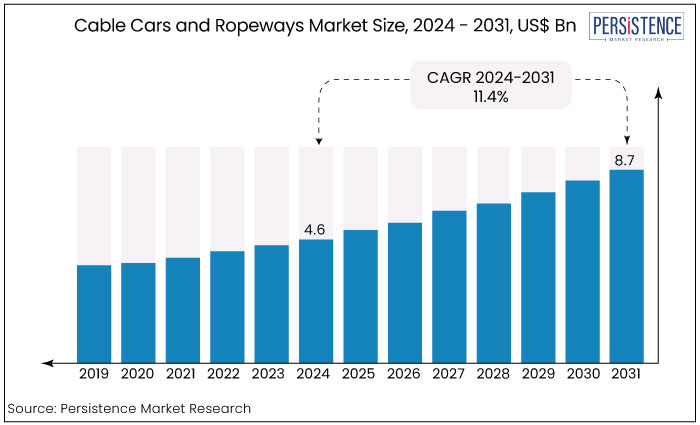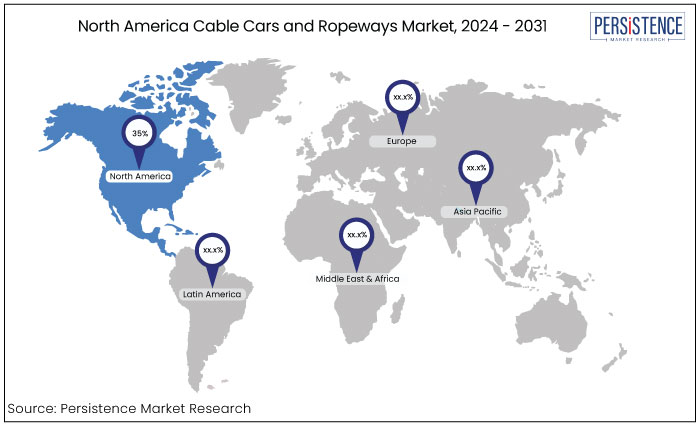Industry: Industrial Automation
Published Date: October-2024
Format: PPT*, PDF, EXCEL
Delivery Timelines: Contact Sales
Number of Pages: 170
Report ID: PMRREP11974
The cable cars and ropeways market is estimated to increase from US$ 4.6 Bn in 2024 to US$ 8.7 Bn by 2031. The market is projected to record a CAGR of 11.4% during the forecast period from 2024 to 2031. The cable cars and ropeways market is driven by growing tourism, and urban mobility adoption, with a focus on sustainability. Asia Pacific shows strong growth potential though high installation and maintenance costs.

Key Highlights of the Market
|
Market Attributes |
Key Insights |
|
Cable Cars and Ropeways Market Size (2024E) |
US$4.6 Bn |
|
Projected Market Value (2031F) |
US$8.7 Bn |
|
Global Market Growth Rate (CAGR 2024 to 2031) |
11.4% |
|
Historical Market Growth Rate (CAGR 2019 to 2023) |
9.5% |
|
Region |
Market Share in 2024 |
|
North America |
35% |
North America dominated the global cable cars and ropeways market owing to the heightened governmental expenditure in tourism infrastructure to entice visitors, and the proliferation of tourism activities propelling market expansion. This region is estimated to account for 35% market share in 2024.
The rapidly growing population and the heightened adoption of cable cars and ropeways as one of the important urban transportation methods are propelling the demand for the cable cars and ropeways market.
Many regional states are undergoing frigid temperatures and substantial snowfall, augmenting tourism activities and increasing the demand for cable cars and ropeways. Consequently, all these reasons propel the expansion of the cable cars and ropeways market.

Numerous cable cars and ropeways are operational in the United States, Algeria, Spain, China, and Brazil for urban transit. Urban areas have begun to recognize the potential of cable cars and ropeways as a solution to mobility requirements enhancing the expansion of the cable car and ropeway market.
|
Category |
Market Share in 2024 |
|
Product Type - Aerial Tramways |
24% |
The market is divided into aerial tramways, funicular ropeways, surface lifts and material ropeways based on product type. Among these, aerial tramways dominate the market. Aerial tramways facilitate connections between regions inaccessible by roads, so conveniently linking tourist destinations and mountain resorts.
Aerial tramways utilize wires, as wires traverse the surface and remain unaffected by soil conditions, rendering them appropriate for diverse topography. Aerial tramways possess larger passenger and cargo capacity than ropeway systems such as funiculars, enabling them to convey more passengers per journey and improving their economic feasibility. Its capacity to traverse extended distances on steep inclines enhances its attractiveness for transportation requirements in challenging terrains.
Aerial tramways provide sweeping vistas throughout the journey, enriching the trip experience, making them a preferred choice for tourists, and contributing to their increased market share in the cable car and ropeways market.
|
Category |
Market Share in 2024 |
|
End Use - Tourism |
45% |
In terms of end use, the market is divided into tourism, public transport and material handling. Among these, the tourism indsutry dominates the market. Cable cars and ropeways improve accessibility and provide access to picturesque sites for recreational and entertainment pursuits. The riding experience through mountainous and valley terrains enhances the inherent beauty of the landscape.
Numerous tourist attractions have established cable car links to renowned locations to enhance tourism, and its superior passenger handling capacity satisfies the requirements of substantial tourist influxes.
The reliance of the tourism sector on cable cars is further amplified by marketing campaigns that highlight distinctive travel experiences. Local authorities frequently utilize ropeway projects to enhance lesser-known tourism destinations. The tourism sector serves as the principal growth catalyst, sustaining its prominent status among end users of cable car and ropeway technologies.
Cable cars and ropeways possess transport systems equipped with installed cables, which utilize a third operational rope for propulsion. These are also accompanied by one or two stationary ropes for support, which are commonly referred to as elevated streetcars.
The ever-growing travel and tourism sector is propelling the demand for cable cars and ropeways to entice visitors, facilitating market growth over the forecast period. The increasing global demand for tourism following the pandemic, coupled with technological developments in ropeway and zip-lining projects, is further propelling the expansion of the cable car and ropeway market.
Aside from their appeal to the tourism sector, cable cars and ropeways also stand out for their environmental friendliness in both construction and operation. Their installation in mountainous regions or over water bodies is a more sustainable alternative to building bridges and roadways. This eco-friendly aspect, combined with their growing popularity in the tourism sector, is making cable cars a standard mode of transportation in mountainous regions.
The cable cars and ropeways market has witnessed consistent growth during the historical period from 2019 to 2023 due to increasing urbanization, tourism, and demand for efficient, eco-friendly transport solutions. During the historical period, the market was driven by advancements in infrastructure projects, particularly in mountainous and tourism-heavy regions.
The global market experienced a steady compound annual growth rate (CAGR) mainly due to rising investments in public transportation to reduce congestion and improve accessibility in hard-to-reach areas. Additionally, the sustainability factor, with cable cars emitting less pollution compared to traditional vehicles, boosted their popularity.
The market is projected to expand at an accelerated pace exhibiting a CAGR of over 11% by 2031, which is anticipated to be fueled by technological innovations such as autonomous cable cars and improvements in safety systems. Also, governments' increasing focus on sustainable urban mobility solutions, along with the expansion of tourist attractions in developing economies will further drive demand.
Increased Global Tourism Remains a Primary Driver
The increasing global tourism activities are propelling the industry's demand for cable cars and ropeways. Cable cars offer exceptional amenities to tourists, serving many purposes such as access systems, standalone attractions, connectivity, and transportation objectives.
Numerous prominent tourist destinations globally use cable cars to elevate the visitor experience and meet expectations from the vantage point. Cable vehicles generate prospects within the travel sector. Other means of travel have numerous advantages; they produce little carbon emissions and have a reduced environmental impact compared to alternative methods of operation.
The cable car contributes to preserving natural beauty by obviating the necessity for road construction and safeguarding the environment. Additionally, the expense associated with cable car construction is far lower than that of surface road development, which propels the expansion of the cable cars and ropeways market.
Urban Mobility and Eco-Friendly Transport Solutions
Urbanization and growing concerns about pollution and traffic congestion have made cable cars and ropeways appealing for urban mobility. Such systems offer a practical alternative to conventional road-based transport in densely populated cities, especially those with difficult topographies.
Cities like Medellín, Colombia, and La Paz, Bolivia, have implemented cable cars as part of their public transportation networks, addressing congestion and accessibility in underserved urban areas. These systems reduce the need for extensive road networks, are energy-efficient, and have a smaller environmental footprint than buses and cars.
Governments are increasingly considering these systems as part of smart city initiatives to reduce urban sprawl, improve public transport, and lower carbon emissions. As cities prioritize greener transportation solutions, cable cars and ropeways are becoming preferred, offering high passenger throughput and low operating costs.
Geographical and Environmental Limitations
Another significant restraint for the Cable Cars and Ropeways market is the geographical and environmental limitations that restrict their applicability in remote areas. While these systems are ideal for mountainous or difficult-to-access regions, their deployment in flat or highly urbanized areas is often not feasible or necessary, limiting their overall market potential.
Weather conditions such as high winds, heavy snowfall, and storms can disrupt operations, posing safety risks and causing service delays. In coastal or tropical regions, harsh environmental factors like humidity and salt can lead to faster corrosion and wear on equipment, increasing maintenance costs and reducing system lifespan.
Regulatory challenges also arise in ecologically sensitive areas, where installing cable cars might face opposition due to environmental concerns such as habitat disruption or visual pollution. These geographical and ecological constraints limit the widespread adoption of cable cars and ropeways, confining their use to specific terrains and conditions.
Increased Demand for Sustainable Transportation Solutions
The increasing demand for sustainable connectivity and transportation solutions augurs positively for the future of suspended cable transport systems. With the global rise in urbanization, there is an escalating demand for sustainable public transportation systems that reduce environmental effects, and cable cars and ropeways provide a distinctive value proposition in this context.
Primarily powered by electricity, they diminish dependence on fossil fuel pollution relative to road cars, and their use of vertical space also enhances the efficiency of transportation infrastructure in densely populated urban areas. Suspended cable systems are increasingly being seen by urban planners as sustainable alternatives or complements to roadways, subways, and railways.
As urban areas expand in size and population density, cable transit can increasingly facilitate the movement of individuals across challenging terrains or boundaries in an environmentally sustainable manner. Examples of their success include the London Cable Car between the Royal Docks and prominent tourist attractions in Rio de Janeiro.
Integration of Autonomous and Smart Technologies
Integrating autonomous and smart technologies represents another major opportunity for the Cable Cars and Ropeways market. With advancements in automation, artificial intelligence (AI), and Internet of Things (IoT) connectivity, cable cars are evolving to become more efficient, safer, and easier to manage.
Autonomous cable car systems with minimal human intervention can reduce labour costs and human error. In contrast, AI-driven systems can optimize performance, predict maintenance needs, and enhance safety. Real-time data collection and analysis through IoT can improve service efficiency by monitoring passenger flow, adjusting schedules dynamically, and detecting mechanical issues before they result in breakdowns.
The development of fully automated cable cars could also broaden their application beyond tourism into sectors like freight transport or urban logistics. This shift toward smarter, autonomous systems will likely redefine the operational capabilities of cable cars and ropeways, offering new business models and expanding market scope.
The presence of several key players, including Doppelmayr Garaventa Group, Leitner Group, POMA Group, and Bartholet Maschinenbau AG, characterizes the competitive landscape of the Cable Cars and Ropeways market.
Leading companies dominate the market by offering advanced technology, extensive product portfolios, and comprehensive after-sales services. They are solid in regions with high tourism or mountainous terrain, such as Europe, North America, and Asia-Pacific.
The competitive environment is marked by innovation, with firms investing in automated and energy-efficient systems to stay ahead. Smaller regional players also compete by focusing on niche markets or specialized applications.
Strategic partnerships, government contracts, and expanding into urban transportation sectors are critical strategies for maintaining competitive advantage.
Recent Industry Developments in the Cable Cars and Ropeways Market
|
Attributes |
Details |
|
Forecast Period |
2024 to 2031 |
|
Historical Data Available for |
2019 to 2023 |
|
Market Analysis |
US$ Billion for Value |
|
Key Regions Covered |
|
|
Key Market Segments Covered |
|
|
Key Companies Profiled in the Report |
|
|
Report Coverage |
|
|
Customization & Pricing |
Available upon request |
By Product Type
By End User
By Region
To know more about delivery timeline for this report Contact Sales
The market is estimated to be valued at US$8.7 Bn by 2031
The market is projected to exhibit a growth rate of 11.4% over the forecast period.
MND Group, Nippon Cable Co., Ltd., POMA, are some of the key players.
North America region dominates the market.
Aerial tramways lead the market with notable market share.